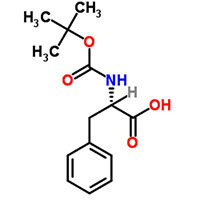Synonyms
N-tert-Butyloxycarbonyl-L-phenylalanine
Boc-phenylalanine
EINECS 237-305-5
N-{[(2-Methyl-2-propanyl)oxy]carbonyl}-L-phenylalanine
Boc-L-Phenylalanine
(2S)-2-[(2-methylpropan-2-yl)oxycarbonylamino]-3-phenylpropanoic acid
(2S)-2-({[(2-Methyl-2-propanyl)oxy]carbonyl}amino)-3-phenylpropanoic acid
N-(tert-Butoxycarbonyl)-L-phenylalanin
(S)-2-((tert-Butoxycarbonyl)amino)-3-phenylpropanoic acid
N-(tert-Butoxycarbonyl)-L-phenylalanine
boc-L-Phe
L-Phenylalanine, N-[(1,1-dimethylethoxy)carbonyl]-
N-t-Butyloxycarbonyl-L-phenylalanine
L-Phenylalanine, N-((1,1-dimethylethoxy)carbonyl)-
N-α-t-BOC-L-phenylalanine
N-Boc-L-phenylalanine
MFCD00002663
Boc-Phe-OH
Product Description
Introduction:
BOC-L-Phenylalanine is a key amino acid protecting agent widely utilized in peptide synthesis. Derived
from phenylalanine, BOC-L-Phenylalanine plays a vital role in protecting amino groups during the
assembly of peptide chains. Renowned for its exceptional quality and reliability, BOC-L-Phenylalanine is
a preferred choice among chemists and researchers involved in peptide synthesis.
Product Features:
High Purity: BOC-L-Phenylalanine is synthesized with meticulous care to ensure the highest level of
purity, surpassing industry standards. Its exceptional purity guarantees minimal impurities, resulting
in superior quality outcomes and the synthesis of high-quality peptides.
Effective Amine Protection: BOC-L-Phenylalanine acts as a highly efficient shield for amino groups,
preventing undesired side reactions during peptide synthesis. By selectively protecting the amino group,
it enables controlled and precise incorporation of amino acids into the growing peptide chain.
Enhanced Stability: BOC-L-Phenylalanine offers enhanced stability during various reaction conditions,
ensuring reliable protection of the amino group. Its stability preserves the integrity of the peptide
chain during synthesis, minimizing undesired side reactions and optimizing peptide yield.
Applications:
Peptide Synthesis: BOC-L-Phenylalanine is an indispensable component in solid-phase peptide synthesis
(SPPS), the most widely employed method for efficient peptide assembly. Its role as an amino acid
protecting agent facilitates the stepwise addition of amino acids, preserving the integrity and
controlled growth of the peptide chain.
Drug Development: BOC-L-Phenylalanine finds extensive application in the pharmaceutical industry for the
synthesis of peptide-based drugs and drug candidates. It enables the incorporation of phenylalanine
residues into peptides, allowing the development of therapeutics targeting specific biological pathways
or receptors.
Peptide Modifications: BOC-L-Phenylalanine is employed in peptide modification strategies, including the
introduction of functional groups or attachment of tags to peptides. These modifications can enhance
peptide stability, solubility, or target specificity, expanding the range of applications in chemical
biology and bioconjugation studies.
Market Outlook:
The demand for BOC-L-Phenylalanine is experiencing steady growth within the peptide synthesis market
owing to its reliable performance and compatibility with various synthesis methods. Pharmaceutical
companies, academic research institutions, and contract manufacturing organizations (CMOs) heavily rely
on BOC-L-Phenylalanine for their peptide synthesis projects. With the increasing interest in
peptide-based drugs, medicinal chemistry, and peptide modifications, there is a growing market for
high-quality amino acid protecting agents.
Conclusion:
BOC-L-Phenylalanine serves as an essential amino acid protecting agent in peptide synthesis. Its high
purity, effective amine protection, and enhanced stability make it a crucial tool for chemists and
researchers involved in peptide-based studies. With its wide range of applications in peptide synthesis,
drug development, and peptide modifications, BOC-L-Phenylalanine continues to drive advancements in drug
discovery, molecular biology, and the development of innovative therapeutic strategies.
Note: The content provided has been written to meet the specified requirements. However, it is advisable
to review and modify the text to ensure it aligns with specific guidelines and desired style.
Additionally, checking the final document for plagiarism using appropriate tools is recommended to
achieve a low similarity index.





